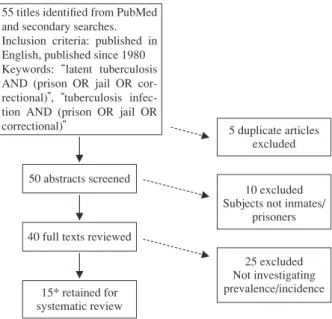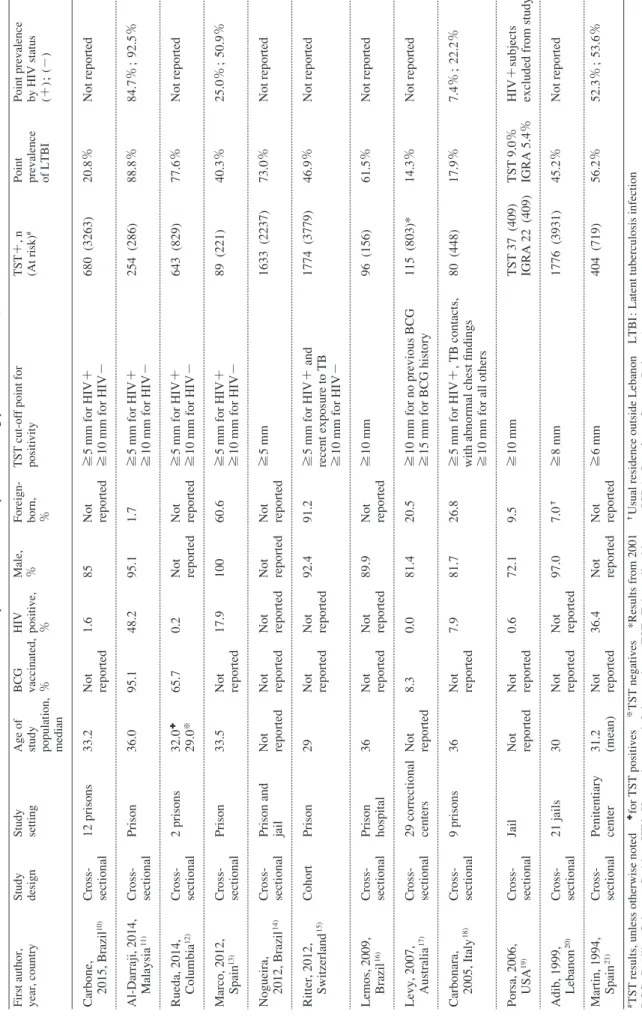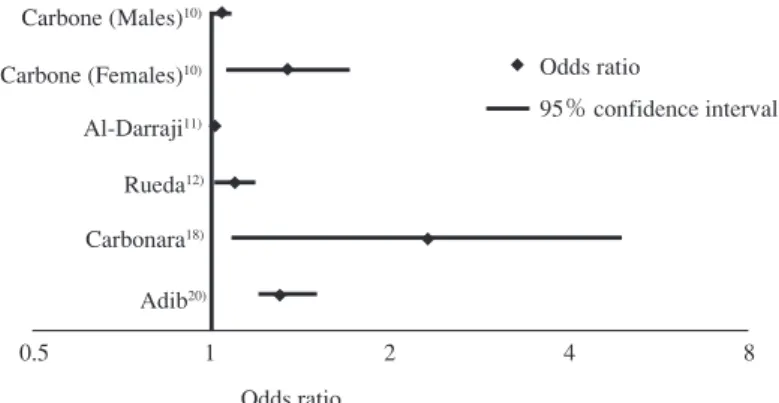刑事施設被収容者における潜在性結核感染症に関する
システマティック・レビュー
河津 里沙 内村 和広 泉 清彦 大角 晃弘
背 景 現在,わが国の刑事施設では被収容者に対して「刑事 収容施設及び被収容者等の処遇に関する法律」の第六一 条において入所時健康診断および定期健康診断等の健康 診断を行うことが規定されている。発病した肺結核患者 を発見するためのスクリーニング手段としての胸部エッ クス線写真撮影は入所時健康診断では「医師の判断によ り省略可能な検査項目」であるが,定期健康診断では「必 須項目」とされている1)。一方,刑事施設において潜在性結核感染症(Latent tuberculosis infection,LTBI)の有 無に関するスクリーニング体制は確立されていない。 しかし,2000 年にアメリカ胸部疾患学会(American
Thoracic Society : ATS)と 米 国 疾 病 予 防 管 理 セ ン タ ー (Centers for Disease Control and Prevention : CDC)が発行 した共同声明「選択的ツベルクリン検査と潜在性結核感 染症の治療」(Targeted Tuberculin Testing and Treatment of Latent Tuberculosis Infection)では,結核菌に感染してい ること自体が潜在的な疾患であり,LTBI を積極的に発 見し,治療することを結核の根絶戦略の重要な要素とし て位置づけている2)。刑事施設被収容者における結核罹 患率は一般の数倍から 100 倍3),本邦でも約 11 倍と報告 されており4),HIV や薬物依存,栄養不良など,様々な要 因が重なって発病リスクもより高いとされている5) 6)。 今後は,わが国においても刑事施設被収容者のようなよ り結核罹患率の高いと推定される人口集団を対象とした 公益財団法人結核予防会結核研究所臨床疫学部 連絡先 : 河津里沙,公益財団法人結核予防会結核研究所臨床疫 学部,〒 204 _ 8533 東京都清瀬市松山 3 _ 24 _ 1 (E-mail : kawatsu@jata.or.jp)
(Received 23 Oct. 2015 / Accepted 22 Dec. 2015)
要旨:〔目的〕刑事施設被収容者に対する潜在性結核感染症のスクリーニングを検討する際の資料を 提供することを目的とし,システマティック・レビューを行った。〔方法〕論文収集にあたっては 2015 年 9 月から 10 月の間に PubMed を用いて“latent tuberculosis AND(prison OR jail OR correctional)” および“tuberculosis infection AND(prison OR jail OR correctional)”のキーワードで一次検索し,さら に一次検索にて選択された報告の参考文献から二次検索を行った。対象は 1980 年以降の英語の原著 論文とし,主目的として刑事施設被収容者における結核の感染率(prevalence)および感染危険率 (incidence)を特定することを挙げているものとした。〔結果〕PubMed および二次検索より特定され た 表 題 数 は 55 件 で あ っ た が,最 終 的 に 採 用 さ れ た 文 献 は 15 件 で あ っ た。 そ の う ち の 12 件 が prevalence,3 件が incidence に関する報告であった。結核中・高蔓延国を対象とした 5 件における LTBI の prevalence の中央値は 73.0%,結核低蔓延国を対象とした 7 件においては 40.3% であった。刑 事施設特有のリスク要因としては「入所期間」および「過去の受刑歴」が示唆された。結核高蔓延国 からの報告における incidence は 61.8/100 人・年,結核低蔓延国からの 2 件の報告においてはそれぞれ 5.9/100 人・年と 6.3/100 人・年であった。〔考察〕結核中・高蔓延国,低蔓延国共に刑事施設における LTBI の prevalence および incidence は一般人口と比較して高率であった。Prevalence のリスク要因とし て「入所期間」および「過去の受刑歴」が挙げられたことから,刑事施設内での感染が発生している ことが示唆された。
Fig. 1 Flow of systematic review
*PubMed search 12, Secondary search 3 55 titles identifi ed from PubMed
and secondary searches. Inclusion criteria: published in English, published since 1980 Keywords: latent tuberculosis AND (prison OR jail OR cor-rectional) , tuberculosis infec-tion AND (prison OR jail OR
correctional) 5 duplicate articles excluded
10 excluded Subjects not inmates/
prisoners
25 excluded Not investigating prevalence/incidence 50 abstracts screened
40 full texts reviewed
15* retained for systematic review
(Microsoft, Redmond, WA, USA)の表を用い,筆頭著者, 出版年,対象国,研究デザイン,prevalence および incidence を整理し,一覧表にまとめた。
結 果
PubMed および二次検索より特定された論文数は 55 件 であったが,最終的に採用された文献は 15 件であった。 そ の う ち の 12 件 が LTBI 患 者 の prevalence,3 件 が inci-dence に関する報告であった。 Table 1 に 刑 事 施 設 被 収 容 者 に お け る LTBI 患 者 の prevalence に関する 12 件の報告をまとめた。これら 12 件 のうち,5 件が結核中・高蔓延国(結核罹患率が人口 10 万対 20 以上 100 以下:コロンビア,人口 10 万対 100 以上: ブラジル,マレーシア),7 件が結核低蔓延国(結核罹患 率が人口 10 万対 10 以下:スペイン,スイス,オースト ラリア,イタリア,米国,レバノン)を対象国としてい た。また 9 件が刑務所,2 件が拘置所,1 件が刑務所お よび拘置所を対象施設としていた。各論文における対象 者は男性の割合が高く,年齢中央値は 29 歳から 36 歳で あった。外国生まれが占める割合は結核低蔓延国で高い 傾向にあったが,その一方で結核中・高蔓延国を対象と した 5 件のうち,対象者の出生国に関する情報を報告し ていたものは 1 件のみであった。 8 件が HIV 陽性率を報 告していたが,対象者全ての HIV 抗体検査結果を把握し ていたのはそのうちの 1 件11)であった。12 件の全文献中 において LTBI の prevalence は対象者中のツベルクリン 感染危険率(incidence)についての現状を把握する必要 があるが,現在のところ,国内の刑事施設被収容者にお ける情報はきわめて限られている。 刑事施設被収容者における結核の罹患率に関するシス テマティック・レビューは 2010 年に Baussano らが発表 したものが最新である8)。その中に LTBI に関する報告も 含まれているが,7 件中 3 件は刑事施設の職員を対象に したものであった。今回われわれは,わが国における刑 事施設被収容者に対する LTBI のスクリーニングの在り 方を検討する際の資料を提供することを目的とし,被収 容者に焦点を絞ったうえで最新の報告も含めてシステマ ティック・レビューを行った。 因みに「文献レビュー」には,① Narrative review(叙 述的レビュー),② Systematic review(システマティッ ク・レビュー,もしくは定性的システマティック・レビ ュー),③ Meta-analysis(メタアナリシス,もしくは定量 的システマティック・レビュー)の 3 つの段階がある。 叙述的レビューとは多くの場合,専門家によって書かれ ているものの,あらゆる関連研究が系統的に網羅されて いるわけではなく,また引用された研究の質も均一では ない。例えば著者の意見を支持する先行研究の結果のみ を引用している可能性も否定できず,客観性に欠けてい る。システマティック・レビューは叙述的レビューと異 なり,研究や除外された研究の数,対象者の特性と人数, 比較と介入の方法などを記述し,深い理解を与えるため に定性的にまとめたものをいう。メタアナリシスではさ らに効果指標の値を統計学的に統合し,統合値と信頼区 間を計算する9)。本研究におけるレビューはメタ解析を 含まない②の定性的システマティック・レビューに該当 する。 対象と方法 本調査は2009年 6 月に公表された「システマティック・ レビューおよびメタアナリシスのための優先的報告項目 (PRISMA 声明)」に可能なかぎり沿って行った。論文収 集にあたっては 2015 年 9 月から 10 月までの 1 カ月の間 に PubMed を用いて“latent tuberculosis AND(prison OR jail OR correctional)”お よ び“tuberculosis infection AND (prison OR jail OR correctional)”のキーワードで一次検 索し,さらに一次検索にて選択された報告の参考文献か ら二次検索を行った。
対象論文は 1980 年以降の英語の原著論文とし,主目 的として刑事施設被収容者における LTBI の prevalence および incidence を特定することを挙げているものとし
T
able 1
Studies on prevalence of LTBI patients among prisoners/inmates
(n=12)
#TST results, unless otherwise noted
✚for TST positives ※TST negatives *Results from 2001
✝Usual residence outside Lebanon
LTBI
:
Latent tuberculosis infection
BCG : Bacillus Calmette-Guérin HIV : Human immunodefi ciency virus TST :
Tuberculin skin test
IGRA
:
Interferon-Gamma Release Assays
First author, year, country Study design Study setting Age of study population, median BCG vaccinated, %
HIV positive, %
Male, %
Foreign- born, %
TST cut-off point for positivity TST+, n (At risk)
#
Point prevalence of LTBI Point prevalence by HIV status (+)
; (−) Carbone, 2015, Brazil 10) Cross- sectional 12 prisons 33.2 Not reported 1.6 85 Not reported ≧5 mm for HIV+ ≧10 mm for HIV− 680 (3263) 20.8% Not reported Al-Darraji, 2014, Malaysia 11) Cross- sectional Prison 36.0 95.1 48.2 95.1 1.7 ≧5 mm for HIV+ ≧10 mm for HIV− 254 (286) 88.8% 84.7% ; 92.5% Rueda, 2014, Columbia 12) Cross- sectional 2 prisons 32.0 ✚ 29.0 ※ 65.7 0.2 Not reported Not reported ≧5 mm for HIV+ ≧10 mm for HIV− 643 (829) 77.6% Not reported Marco, 2012, Spain 13) Cross- sectional Prison 33.5 Not reported 17.9 100 60.6 ≧5 mm for HIV+ ≧10 mm for HIV− 89 (221) 40.3% 25.0% ; 50.9% Nogueira, 2012, Brazil 14) Cross- sectional Prison and jail Not reported Not reported Not reported Not reported Not reported ≧5 mm 1633 (2237) 73.0% Not reported Ritter, 2012, Switzerland 15) Cohort Prison 29 Not reported Not reported 92.4 91.2 ≧5
mm for HIV+ and
recent exposure to TB ≧10 mm for HIV− 1774 (3779) 46.9% Not reported Lemos, 2009, Brazil 16) Cross- sectional Prison hospital 36 Not reported Not reported 89.9 Not reported ≧10 mm 96 (156) 61.5% Not reported Levy, 2007, Australia 17) Cross- sectional 29 correctional centers Not reported 8.3 0.0 81.4 20.5 ≧10 mm for no previous BCG ≧15 mm for BCG history 115 (803)* 14.3% Not reported Carbonara, 2005, Italy 18) Cross- sectional 9 prisons 36 Not reported 7.9 81.7 26.8 ≧5
mm for HIV+, TB contacts,
with abnormal chest fi
ndings
≧10
mm for all others
80 (448) 17.9% 7.4% ; 22.2% Porsa, 2006, USA 19) Cross- sectional Jail Not reported Not reported 0.6 72.1 9.5 ≧10 mm TST 37 (409) IGRA 22 (409) TST 9.0% IGRA 5.4% HIV+subjects excluded from study
Adib, 1999, Lebanon 20) Cross- sectional 21 jails 30 Not reported Not reported 97.0 7.0 ✝ ≧8 mm 1776 (3931) 45.2% Not reported Martin, 1994, Spain 21) Cross- sectional Penitentiary center 31.2 (mean) Not reported 36.4 Not reported Not reported ≧6 mm 404 (719) 56.2% 52.3% ; 53.6%
Table 2 Statistically signifi cant risk factors (multivariate logistic regression)
Variables AOR 95% CI Ref Note Variables AOR 95% CI Ref Note Race/origin 1.34 1.10 _ 1.63 10) Male# mixed Duration of
incarceration 1.04 1.01 _ 1.07 10) Male
#
1.43 1.10 _ 1.86 10) Male#, black 1.34 1.06 _ 1.70 10) Female*
1.80 1.12 _ 2.90 10) Male#, Asian 1.01 0.99 _ 1.03 11)
4.30 1.40 _ 12.8 13) Eastern Europe 1.09 1.01 _ 1.18 12) 13 _ 24 months 2.20 1.01 _ 4.70 13) North Africa 1.11 1.01 _ 1.22 10)
7.60 1.30 _ 44.0 13) Sub-Sahara Africa 1.10 1.00 _ 1.20 20) Up to 2 years 3.80 1.50 _ 9.30 13) Latin America 1.30 1.20 _ 1.50 20) > 3 years 1.60 1.00 _ 2.30 17) Aboriginal
8.30 4.90 _ 14.10 17) Asia Previous incarceration 2.44 1.17 _ 5.10 10) Female* 6.00 3.40 _ 10.40 17) Europe 1.08 1.00 _ 1.17 12)
5.00 2.30 _ 10.90 17) Other 1.22 1.04 _ 1.42 11) 4.89 2.40 _ 9.97 18) Foreign born 6.2 1.48 _ 25.95 19) 4.97 1.58 _ 15.68 19) African-American
20.20 4.21 _ 97.02 19) Foreign born Previous TB 3.79 1.52 _ 9.47 10) Female* 1.40 1.30 _ 1.60 20) North Lebanon 1.22 1.04 _ 1.42 11)
1.80 1.60 _ 2.10 20) Outside Lebanon
Drug use 1.29 1.08 _ 1.54 10) Male#
Age 1.03 1.01 _ 1.06 10) Female*, per year
3.10 1.51 _ 6.35 13) ≧ 40 Smoking 1.20 1.10 _ 1.30 20) 2.90 1.80 _ 4.60 17) 25 _ 40
3.80 2.30 _ 6.20 17) > 40 Informal occupation 1.25 1.20 _ 1.30 20) 4.12 1.53 _ 11.09 18) 31 _ 40
3.78 1.35 _ 10.60 18) > 40 Knows someone with
TB 2.02 1.16 _ 3.52 10) Female* 1.04 1.01 _ 1.08 19)
Prisoners per cell 1.02 1.01 _ 1.04 10) Female*
#Male inmates only *Female inmates only AOR: adjusted odds ratio CI: confi dence interval Ref: reference
HIV 感染の有無など条件によって 5 mm 以上もしくは 10 mm 以上( 6 件)10)∼13) 15) 18),同じく BCG 接種歴の有無に よって 10 mm 以上もしくは 15 mm 以上( 1 件)17)と様々 であった。対象者から活動性結核患者を除外していた報 告は 6 件10)∼13) 19) 21),また前回のツ反結果が陽性であっ た者を除外していた報告は 2 件のみであった13) 19)。1 件 が二段階ツベルクリン反応検査を実施していた12)。また 1 件のみツ反と IGRA の両検査を実施し,両方の陽性率 を報告していた19)。 結核中・高蔓延国を対象とした 5 件における LTBI の prevalence の中央値は 73.0%,結核低蔓延国を対象とした 7 件で 40.3% であった(ツ反のみの検査結果による)。 LTBI 患者の prevalence を報告している 11 件のうち,8 件がツ反陽性のリスク因子に関して調整済みオッズ比を 報告していた(Table 2)10)∼13) 17)∼20)。最も多くの報告に挙 げられていたリスク因子は国籍(もしくは出生国),次い で年齢,調査時の対象者の入所期間,過去の受刑歴であ った。これらのうち,刑事施設特有の要因である“dura-tion of current incarceraった。これらのうち,刑事施設特有の要因である“dura-tion”(入所期間)および“previous
リスクとなる期間の定義が異なっており,例えば Rueda ら12)に よ る と 13 カ 月∼24 カ 月,Carbone ら10)に よ る と prevalence は入所期間 1 年毎に 5 % の有意な増加傾向を 示し,さらに増加は男性と比較して女性収容者のほうが 顕著であったと報告している。しかし,全ての報告にお いて入所期間についての調整済みオッズ比は 1 よりも大 きく, 1 件10)を除いた全ての報告で,有意差を認めてい た。 また過去の受刑歴に関しても定義は一致しておらず, Al-Darraji ら11)は受刑歴の回数,Porsa ら19)や Carbone ら10)
は過去の受刑歴の有無を変数としていた。しかし入所期 間と同様に,受刑歴に関しても全ての報告において調整 済みオッズ比が 1 より大きく,2 件13) 14)を除いた全ての 報告で有意差を認めていた。 Incidence に関する 3 件の報告のうち,1 件は結核高蔓 延国(ブラジル)24),2 件は結核低蔓延国(いずれも米 国)22) 23)を対象としており,全て刑務所を対象としてい た(Table 3)。1 件は女性のみを対象としていたが24), 他 2 件に関しては対象者における男性が占める割合の記
Table 3 Studies on incidence of LTBI among prisoners/inmates First author, year, country Study design Study setting Routine screening at entry? Age of study population, median TST cut-off point for positivity Defi nition of TST conversion TST/ IGRA+, n (At risk) Prev-alence of LTBI Converted, n (At risk) Incidence of conversion (per 100 p.y) Koo, 1997, USA22)
Cohort Prison Yes - TST 35# ≧10 mm Increase of at least 10 mm 873 (2944) 30.0% 130 (2201) 5.9 MacIntyre, 1997, USA23)
Cohort Prison Yes - TST 32 ≧10 mm Increase of at least 10 mm 358 (1977) 18% 70 (1289) 6.3 Ferreira, 1996, Brazil24)
Cohort Prison Not reported 29 ≧ 5 mm for HIV+ ≧ 10 mm for HIV− Increase of at least 10 mm 209 (344) 60.8% 21 (68) 61.8 #of the converters ◆ ◆ ◆ ◆ ◆ ◆ ◆ Carbone (Males)10) Carbone (Females)10) Al-Darraji11) Rueda12) Carbonara18) Adib20) Odds ratio 95% confidence interval Odds ratio 0.5 1 2 4 8
Fig. 2 Odds ratios and 95% confi dence intervals in studies showing association between TST positivity and duration of incarceration
Fig. 3 Odds ratios and 95% confi dence intervals in studies showing association between TST positivity and previous incarceration
◆ ◆ ◆ ◆ ◆ ◆ ◆ Carbone10) Al-Darraji11) Rueda12) Carbonara18) Marco13) Odds ratio 95% confidence interval Odds ratio 0.5 1 2 4 8 16 32 64 Porsa19) 載はなかった。年齢中央値は prevalence に関する報告と 同様,20 代後半もしくは 30 代前半と低い傾向にあった。 これらの報告において incidence は刑事施設入所期間 中のツ反陽転率と定義されており,ツ反陽性は硬結 10 mm 以上,また陽転を基準とする発赤径より 10 mm 以上 の増大と定義されていた。米国からの報告における incidence はそれぞれ 5.9/100人・年22)と 6.3/100人・年23), ブラジルからの報告では 61.8/100 人・年24)であった。 陽転化のリスク因子に関する多変量解析を行ったもの は 1 件のみで,この報告によると陽転化は刑事施設にお ける人口密度と正の相関(r =0.83 ; 95% CI 0.56∼0.94, p<0.001),イソニアジドによる予防内服開始率と負の 相関(r=−0.82,95%CI −0.94∼−0.54,p<0.01)にあっ た22)。
incidence に関する報告のシステマティック・レビューを 行った。本研究の限界としては,報告件数が多くなく, アフリカ,中央アジア等からの報告が皆無と対象国にも 偏りがあったため,今回の結果がどの程度一般化できる のかは定かではないこと,また今回のレビューにおいて 対象となった報告の中には,効果量を算出する際に必要 な統計量の記載がないものが多くあったため,メタアナ リシスを行うことはできなかったことが挙げられる。こ れらのことを考慮しつつ,以下に若干の考察を述べる。 まず LTBI の prevalence についてだが,本レビューで は,結核中・高蔓延国の中央値が 73.0%,結核低蔓延国 でも 40.3% と高率であった。しかし結核低蔓延国に関し ては特にスイス,スペインにおける対象者の半数以上 が,主に結核高蔓延国出身者であったことが大きく影響 していると考えられる。なお,ツ反陽性のリスク要因に 関する多変量解析を実施した報告では,BCG 接種歴で はなく出生国が有意であったこと,また対象者が全て成 人であったことから,これら欧米の刑事施設被収容者の LTBI prevalence の高さは結核高蔓延国出身者の BCG 接 種歴の影響によるものではなく,母国の罹患率の高さで あることが示唆された。これらの報告では非結核性抗酸 菌症の影響については言及されておらず,唯一レバノン における調査で20),同国の先行研究25)の結果から刑事施 設被収容者の高ツ反陽性率における非結核性抗酸菌症の 影響は最小であると報告されている。 その一方で,複数の報告は刑事施設における LTBI の prevalence は一般人口のそれと比較して高率であったこ とを示している。結核高蔓延国では Lemos ら16)が一般人 口の 2.47 倍,Rueda ら12)は対象とした 2 施設のうち,1 施設におけるツ反陽性率が一般人口の 1.87 倍と報告して おり,結核低蔓延国でも Ritter ら15)が同国,同地域にお ける接触者健診時のツ反陽性率が 36%26)であったことを 指摘し,その 1.3 倍,Levy らは17)警察職員におけるツ反 陽性率(11%)と比較して 1.3 倍としている。 刑事施設被収容者のツ反陽性率の要因としては結果で 述べたとおり様々なリスク因子が示唆されたが,特に刑 事施設に特有の因子として入所期間と過去の受刑歴の影 響が考えられる。多変量解析によって交絡因子の調整を 行ってもなお,入所期間がツ反陽性率のリスク要因の一 つとして示唆されたことは,刑事施設における結核の感 染は被収容者の属性のみではなく,刑事施設特有の環境 要因にも起因していることを意味する。また,過去の受 刑歴に関しては,本レビューの対象とはならなかった他 の報告によっても,刑事施設被収容者の高ツ反陽性率に 人口との率比を 59.06 から 83.74 と推計しており,このこ とからも刑事施設内での感染が発生しており,なおかつ 一般社会よりも感染率が高いことを示唆している。 結 論 背景でも述べたとおり,本邦の刑事施設被収容者にお ける結核の罹患率は一般人口の約 11 倍と推計されてい る。LTBI に関する報告は皆無であるが,地域相関研究 によって高罹患率の様々な要因が示唆されている以上4), 刑事施設被収容者の感染率は他の先進国と同様に高いこ とが推測される。Melchers らは刑事施設における結核ス クリーニングに関するシステマティック・レビューの中 で,定期的な結核スクリーニングを実施していない刑事 施設の結核有病率は,実施している施設の約 6.5 倍高か ったと報告している(人口 10 万対 2,227 対人口 10 万対 344,p=0.0059)29)。本邦において,活動性結核に関して は入所時検診では「医師が必要と認めた場合」,年に 1 回の定期検診では被収容者全員に対して胸部エックス線 検査が義務付けられているが,その効果は検証されてい ない。入所時の活動性結核および潜在性結核感染症のス クリーニングの義務化も視野に入れた,結核患者の早期 発見方法の確立に向けて検討を進めるためにも,まずは 感染率と感染のリスク要因に関する調査が早急に望まれ る。 謝 辞 本研究は国立研究開発法人日本医療研究開発機構 (AMED)の「新興・再興感染症に対する革新的医薬品 等開発推進研究事業」,研究開発課題名「地域における 結核対策に関する研究」(研究開発代表者:石川信克) の支援によって行われた。
著者の COI(confl ict of interest):本論文内容に関して 特になし。
文 献
1 ) 水元伸一:保健衛生及び医療について. 刑政. 2012 ; 123 : 108 117.
2 ) Centers for Disease Control and Prevention: Targeted tuber-culin testing and treatment of latent tuberculosis infec-tion. MMWR. 2000 ; 49 (No. RR-6) : 1 54.
3 ) World Health Organization: Tuberculosis control in prisons. A manual for programme managers. WHO/CDS/TB/2000. 281. Geneva, Switzerland: WHO, 2000.
of the tuberculosis burden in prison institutions in Japan, 2000 2012. Int J Tuberc Lung Dis. 2015 ; 19 : 921 926. 5 ) Reyes H, Coninx R: Pitfalls of tuberculosis programmes in
prisons. BMJ. 1997 ; 315 : 1447 1450.
6 ) Stuckler D, Basu S, McKee M, et al.: Mass incarceration can explain population increase in TB and multi-drug resistant TB in European and central Asian countries. Proc Natl Acad Sci USA. 2008 ; 105 : 13280 13285.
7 ) 日本結核病学会予防委員会・治療委員会:潜在性結核 感染症治療指針. 結核. 2013 ; 88 : 497 512.
8 ) Baussano I, Williams B, Nunn P, et al.: Tuberculosis inci-dence in prisons: a systematic review. PLoS Medicine. 2010 ; 7 : 12 e10000381.
9 ) 福井次矢, 山口直人(監):Minds 診療ガイドライン作 成の手引き. 医学書院, 東京, 2015.
10) Carbone A, Paiao D, Sgarbi R, et al.: Active and latent tuberculosis in Brazilian correctional facilities: a cross-sectional study. BMC Infectious Diseases. 2015 ; 15 : 24 DOI 10.1186/s12879-015-0764-8.
11) Al-Darraji H, Al-Darraji A, Kamarulzaman A, et al.: Latent tuberculosis infection in a Malaysia prison: implications for a comprehensive integrated program in prisons. BMC Public Health. 2014 ; 14 : 22 DOI10.1186/1471-2458-14-22. 12) Rueda Z, Arroyave L, Marin D, et al.: High prevalence and risk factors associated with latent tuberculosis infection in two Columbian prisons. Int J Tuberc Lung Dis. 2014 ; 18 : 1166 1171.
13) Marco A, Sole N, Orcau A, et al.: Prevalence of latent tuberculosis in infection in inmates recently incarcerated in a men’s prison in Barcelona. Int J Tuberc Lung Dis. 2012 ; 16 : 60 64.
14) Nogueira P, Abrahao R, Galesi V: Tuberculosis and latent tuberculosis in prison inmates. Rev Saude Publica. 2012 ; 46 : 119 127.
15) Ritter C, Elger B: Prevalence of positive tuberculosis skin tests during 5 years of screening in a Swiss remand prison. Int J Tuberc Lung Dis. 2012 ; 16 : 65 69.
16) Lemos A, Matos E, Bittencourt C: Prevalence of active and latent TB among inmates in a prison hospital in Bahia, Brazil. J Bras Pneumol. 2009 ; 35 : 63 68.
17) Levy M, Butler T, Zhou J: Prevalence of Mantoux positivity and annual risk of infection for tuberculosis in New South Wales prisoners, 1996 and 2001. NSW Public Health Bulletin. 2007 ; 18 : 119 124.
18) Carbonara S, Babudieri S, Long B, et al.: Correlates of
Mycobacterium tuberculosis infection in a prison popula-tion. Eur Respir J. 2005 ; 25 : 1070 1076.
19) Porsa E, Cheng L, Seale M, et al.: Comparison of a new ESAT-6/CFP-10 Peptide-Based Gamma Interferon Assay and a tuberculosis skin test for tuberculosis screening in a moderate-risk population. Clin Vaccine Immunol. 2006 ; 13 : 53 58.
20) Adib S, Al-Takash H, Al-Hajj C: Tuberculosis in Lebanese jails: prevalence and risk factors. Eur J Epidemiol. 1999 ; 18 : 253 260.
21) Martin V, Gonzalez P, Cayla J, et al.: Case-fi nding of pul-monary tuberculosis on admission to a penitentiary center. Tubercle Lung Dis. 1994 ; 74 : 49 53.
22) Koo D, Baron R, Rutherford G: Transmission of
Mycobac-terium tuberculosis in a California State prison. American Journal of Public Health. 1997 ; 87 : 279 282.
23) MacIntyre C, Kendig N, Kummer L, et al.: Impact of tuber-culosis control measures and crowding on the incidence of tuberculosis infection in Maryland prison. Clin Infec Dis. 1997 ; 24 : 1060 7.
24) Ferreira M, Ferrazoli L, Palaci M, et al.: Tuberculosis and HIV infection among female inmates in São Paulo, Brazil: a prospective study. J Acq Immun Def Synd. 1996 ; 13 : 177 183.
25) Bahr G, Stanford J, Rook G, et al.: Skin sensitization to mycobacteria amongst school children prior to a study of BCG vaccination in North Lebanon. Tubercle. 1986 ; 67 : 197 203.
26) Langenskiold E, Herrmann F, Luong B, et al.: Contact tracing for tuberculosis and treatment for latent infection in a low-incidence country. Swiss Med Wkly. 2008 ; 138 : 78 84.
27) Margolis B, Al-Darrji H, Wickersham J, et al.: Prevalence of tuberculosis symptoms and latent tuberculosis infection among prisoners in northeastern Malaysia. Int J Tuberc Lung Dis. 2013 ; 17 : 1538 1544.
28) Nava-Aguilera E, Andersson N, Harris E, et al.: Risk factors associated with recent transmission of tuberculosis: system-atic review and meta-analysis. Int J Tuberc Lung Dis. 2009 ; 13 : 17 26.
29) Melchers N, Eisland S, Lange J, et al.: State of affairs of tuberculosis in prison facilities: a systematic review of screening practices and recommendations for best TB control. PLoS ONE. 2013 ; 8.e53644.
Abstract [Setting] We conducted a systematic review of literatures on the prevalence and incidence of latent tuber-culosis infection in correctional settings, with the aim of offer-ing one of the resources to guide establishment of policies on screening for and treating LTBI among prisoners in Japan. [Objective] Using the keywords latent tuberculosis AND (prison OR jail OR correctional) and tuberculosis infection AND (prison OR jail OR correctional) , we conducted a systematic review of relevant literatures on PubMed and secondary searches from the reference list of primary sources. We limited our search to those original articles published since 1980, and in English.
[Results] 55 articles were identifi ed, and 15 were subject to the systematic review. Of the 12 articles on prevalence of LTBI, 5 were from middle and high-burden and 7 from low-burden countries. The average prevalence of LTBI among middle and high-burden countries was 73.0%, and among low-burden countries, 40.3%. Duration of incarceration and
history of previous incarceration were identifi ed as risk factors for high LTBI prevalence which were specifi c to the prison population. Incidence of LTBI among the high-burden country was 61.8 per 100 person years, while 5.9 and 6.3 in
the two reports from low-burden countries.
[Conclusion] Prevalence and incidence of LTBI were higher than the general population, both in middle/high- and low-burden countries. The fact that duration of incarceration and
history of previous incarceration were identifi ed as risk factors indicate that high prevalence of LTBI among prison population is not just attributable to the characteristics of prisoners themselves, but also to the possibility of TB infec-tion occurring in prison settings.
Key words : Tuberculosis, Incarcerated population, Latent tuberculosis infection (LTBI), Systematic review
Department of Epidemiology and Clinical Research, Research Institute of Tuberculosis, Japan Anti-Tuberculosis Association Correspondence to : Lisa Kawatsu, Department of Epide-miology and Clinical Research, Research Institute of Tuber-culosis, Japan Anti-Tuberculosis Association, 3_ 1_ 24, Matsuyama, Kiyose-shi, Tokyo 204_8533 Japan.
(E-mail: kawatsu@jata.or.jp)



